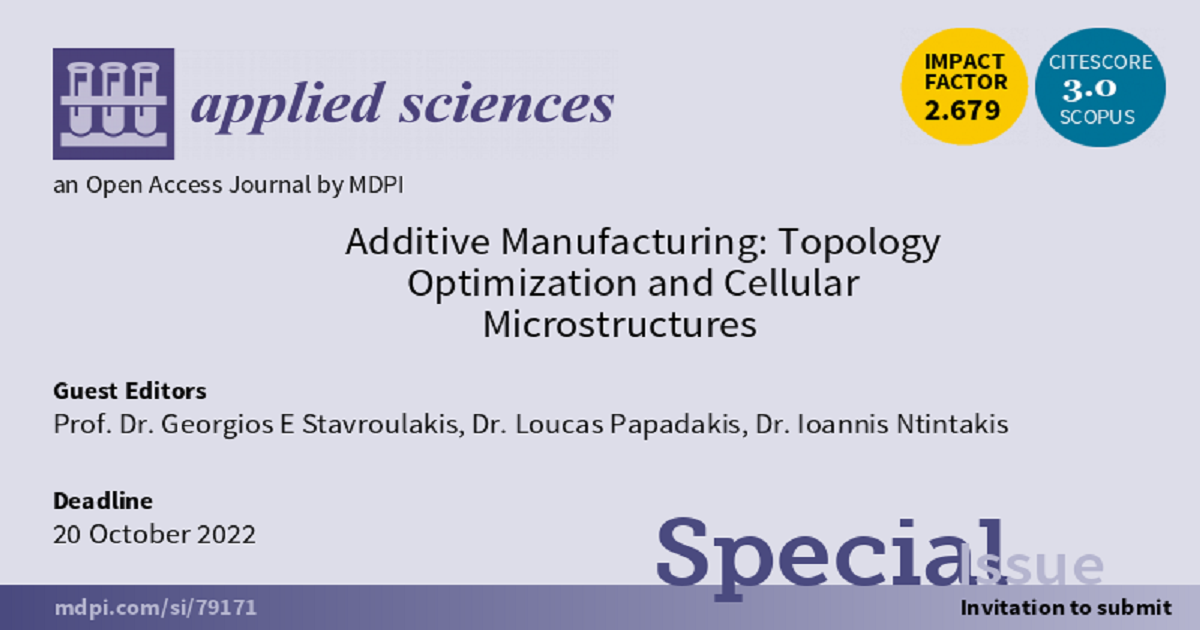Additive Manufacturing: Topology Optimization and Cellular Microstructures
A special issue of Applied Sciences (ISSN 2076-3417). This special issue belongs to the section "Mechanical Engineering".
Deadline for manuscript submissions: closed (20 October 2022) | Viewed by 42310

Special Issue Editors
Interests: computational mechanics; smart structures; identification; structural control
Special Issues, Collections and Topics in MDPI journals
Interests: manufacturing processes; additive manufacturing; thermomechanical modelling’ vehicle structures
Special Issues, Collections and Topics in MDPI journals
Interests: design for additive manufacturing; product design; topology optimization; lightweight structures
Special Issues, Collections and Topics in MDPI journals
Special Issue Information
Dear Colleagues,
Topology optimization (TO) is a mathematical method that spatially optimizes the distribution of material within a defined domain, by fulfilling predefined constraints and, if required, the cost function. However, topology optimization results are characterized by high complexity. The proposed optimized structures are difficult to manufacture with subtractive technologies. Additive manufacturing (AM) is a well-established technology already applied for the fabrication of structural components with nearly no geometric constraints. The combination of TO and AM allows for the creation of optimized parts with reduced mass and increased stiffness. Additive manufacturing leads to new structural design constraints and manufacturing defects, such as porosity and unmelt regions, shape inaccuracy after support structures removal, degradation of material properties, etc. Additionally, defects induced during additive manufacturing processes including unmelt regions and pores are the main cause of fatigue failure. These defects may cause crack initiation under cyclic loading.
Developments in AM techniques enable the fabrication of materials with intricate cellular architectures. A rapidly growing research area of cellular structures is auxetic materials with negative Poisson’s ratio (NPR). These materials expand in the lateral direction when stretched longitudinally or contract laterally under uniaxial compression. These materials possess a combination of high stiffness and strength with significant weight savings and demonstrate a series of particular characteristics over conventional materials, such as excellent indentation resistance, high shear stiffness, remarkable fracture toughness, and unique acoustic energy and impact absorption abilities.
The purpose of this Special Issue is to encourage the two scientific communities of additive manufacturing and topology optimization to focus on this novel and rapidly growing research area. In addition to the above fields, example topics may include new auxetic materials applications, machine learning applications, and novel algorithms linking topology optimization with additive manufacturing. This issue will publish original research papers, short reports, and reviews related to cellular structures fabricated with 3D printing and topology optimization methods for additive manufacturing.
Prof. Dr. Georgios Ε Stavroulakis
Dr. Loucas Papadakis
Dr. Ioannis Ntintakis
Guest Editors
Manuscript Submission Information
Manuscripts should be submitted online at www.mdpi.com by registering and logging in to this website. Once you are registered, click here to go to the submission form. Manuscripts can be submitted until the deadline. All submissions that pass pre-check are peer-reviewed. Accepted papers will be published continuously in the journal (as soon as accepted) and will be listed together on the special issue website. Research articles, review articles as well as short communications are invited. For planned papers, a title and short abstract (about 100 words) can be sent to the Editorial Office for announcement on this website.
Submitted manuscripts should not have been published previously, nor be under consideration for publication elsewhere (except conference proceedings papers). All manuscripts are thoroughly refereed through a single-blind peer-review process. A guide for authors and other relevant information for submission of manuscripts is available on the Instructions for Authors page. Applied Sciences is an international peer-reviewed open access semimonthly journal published by MDPI.
Please visit the Instructions for Authors page before submitting a manuscript. The Article Processing Charge (APC) for publication in this open access journal is 2400 CHF (Swiss Francs). Submitted papers should be well formatted and use good English. Authors may use MDPI's English editing service prior to publication or during author revisions.
Keywords
- design for AM
- lightweight, topological, lattice, and cellular structures
- auxetic structures
- materials for AM
- surface finish and post processing operations
- thermomechanical analysis for shape distortion prediction and compensation
- reverse engineering methods
- integrated computational materials engineering (ICME) in additive manufacturing
- defects and stress inspection of 3D printed structures
- support structures
- artificial intelligence and machine learning for AM
Benefits of Publishing in a Special Issue
- Ease of navigation: Grouping papers by topic helps scholars navigate broad scope journals more efficiently.
- Greater discoverability: Special Issues support the reach and impact of scientific research. Articles in Special Issues are more discoverable and cited more frequently.
- Expansion of research network: Special Issues facilitate connections among authors, fostering scientific collaborations.
- External promotion: Articles in Special Issues are often promoted through the journal's social media, increasing their visibility.
- Reprint: MDPI Books provides the opportunity to republish successful Special Issues in book format, both online and in print.
Further information on MDPI's Special Issue policies can be found here.







